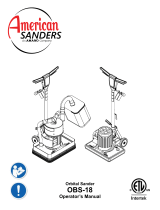
5
en
The outside diameter and the thickness of your
accessory must be within the capacity rating of
your power tool. Incorrectly sized accessories
cannot be adequately guarded or controlled.
The arbor size of wheels, flanges, backing pads
or any other accessory must properly fit the
spindle of the power tool. Accessories with
arbor holes that do not match the mounting
hardware of the power tool will run out of
balance, vibrate excessively and may cause
loss of control.
Do not use a damaged accessory. Before each
use inspect the accessory such as abrasive
wheels for chips and cracks, backing pad for
cracks, tear or excess wear, wire brush for
loose or cracked wires. If power tool or acces-
sory is dropped, inspect for damage or install
an undamaged accessory. After inspecting and
installing an accessory, position yourself and
bystanders away from the plane of the rotating
accessory and run the power tool at maximum
no-load speed for one minute. Damaged acces-
sories will normally break apart during this
test time.
Wear personal protective equipment. Depend-
ing on application, use face shield, safety gog-
gles or safety glasses. As appropriate, wear
dust mask, hearing protectors, gloves and
workshop apron capable of stopping small
abrasive or workpiece fragments. The eye
protection must be capable of stopping flying
debris generated by various operations. The
dust mask or respirator must be capable of fil-
trating particles generated by your operation.
Prolonged exposure to high intensity noise
may cause hearing loss.
Keep bystanders a safe distance away from
work area. Anyone entering the work area must
wear personal protective equipment. Frag-
ments of workpiece or of a broken accessory
may fly away and cause injury beyond imme-
diate area of operation.
Hold power tool by insulated gripping surfaces
only, when performing an operation where the
cutting accessory may contact hidden wiring or
its own cord. Cutting accessory contacting a
“live” wire may make exposed metal parts of
the power tool “live” and shock the operator.
Position the cord clear of the spinning acces-
sory. If you lose control of the power tool,
the cord may be cut or snagged and your
hand or arm may be pulled into the spinning
accessory.
Never lay the power tool down until the acces-
sory has come to a complete stop. The spin-
ning accessory may grab the surface and pull
the power tool out of your control.
Do not run the power tool while carrying it at
your side. Accidental contact with the spin-
ning accessory could snag your clothing, pull-
ing the accessory into your body.
Regularly clean the power tool’s air vents. The
motor’s fan will draw the dust inside the
housing and excessive accumulation of pow-
dered metal may cause electrical hazards.
Do not operate the power tool near flammable
materials. Sparks could ignite these materials.
Do not use accessories that require liquid cool-
ants. Using water or other liquid coolants
may result in electrocution or shock.
Kickback and related warnings
Kickback is a sudden reaction to a pinched or
snagged rotating wheel, backing pad, brush or
any other accessory. Pinching or snagging
causes rapid stalling of the rotating accessory
which in turn causes the uncontrolled power
tool to be forced in the direction opposite of
the accessory’s rotation at the point of the
binding.
For example, if an abrasive wheel is snagged
or pinched by the workpiece, the edge of the
wheel that is entering into the pinch point can
dig into the surface of the material causing the
wheel to climb out or kick out. The wheel
may either jump toward or away from the
operator, depending on direction of the
wheel’s movement at the point of pinching.
Abrasive wheels may also break under these
conditions.
Kickback is the result of power tool misuse
and/or incorrect operating procedures or
conditions and can be avoided by taking
proper precautions as given below.
3 41 01 130 21 0.book Seite 5 Freitag, 18. Dezember 2009 7:47 07






















